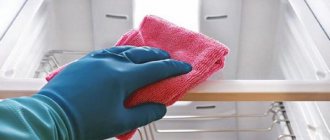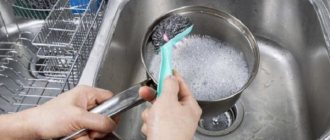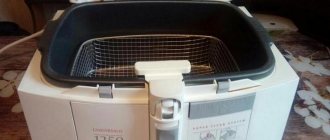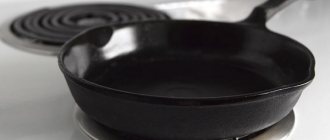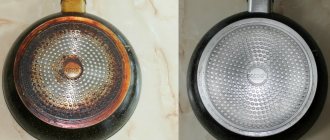- How often should you clean your refrigerator?
- How to clean a refrigerator?
- How do you clean the refrigerator?
- How to eliminate odor in the refrigerator?
Those times have already been forgotten when the refrigerator had to be defrosted and washed once a month without fail in order to get rid of ice in the freezer. However, this does not mean that modern technology does not require regular maintenance. How to properly clean a refrigerator and how often? How to clean refrigerators and freezers of the No Frost system, and how to get rid of the smell inside?
How often should you clean your refrigerator?
Timely cleaning is necessary for any refrigerator; cleaning and washing should not involve defrosting the ice. A clean refrigerator is the key to good health and well-being. Hygiene and disinfection in the place where food is stored allows food to remain fresh longer and protects against harmful microorganisms entering the body with food.
After all, despite the fact that the temperature in the refrigerator is low, this does not stop the growth of bacteria and microbes, but only slows it down. There are types of mold that live even at -4 °C. And when fungal enzymes enter the body, they disrupt metabolism and destroy the protection of cell membranes, making them defenseless against infections. Therefore, regular and proper cleaning of the refrigerator and compliance with storage standards for the contents is a must for a good housewife who cares about the health of her loved ones and herself.
No Frost - prevents condensation from forming by moving air in the chamber using a fan. Drip system - when the condenser automatically works so that moisture accumulates on the air cooler, turns into ice crystals and periodically thaws, flowing into a container for evaporation.
How often should you completely clean your refrigerator? It is believed that once every two weeks is optimal for maintaining sanitary standards. But it’s worth keeping the refrigerator compartment clean all the time:
- Clean up crumbs, spills and other stains.
- Wash external surfaces, especially areas that are frequently touched with hands.
- Place only clean dishes on the shelves.
- Do not keep raw meat, fish, berries in bags, but transfer them to a bowl so that there are no traces or drips left.
- Place vegetables in the refrigerator washed and dried.
- Store products in separate closed containers or under cling film. Especially if the refrigerator has a no-frost system. Immediately get rid of expired or spoiled ones.
This way, there is less pollution, and unpleasant odors do not permeate the plastic. Then “general” cleaning will be easier and faster.
Manufacturers recommend that No Frost refrigerators be completely defrosted once a year for prevention, while modern ones with a drip auto-defrost system should be defrosted every 3-6 months, or according to the instructions.
Review of the best household chemicals
If you are wondering how to clean a refrigerator, you should turn to household chemicals for help. On sale you can find special refrigerator cleaning products that allow you to quickly get rid of plaque, yellowness and other contaminants. With the help of such compositions you can eliminate unpleasant odors in the refrigerator, remove mold and perform antimicrobial treatment.
You can buy such products at hardware stores, where they are sold in spray bottles. The advantage of sprays and gels is the absence of chemical odor and toxic substances.
In search of good solutions for yellowness, you should be guided by the following recommendations:
- Choose only those formulations that are designed for cleaning refrigerators. For routine hygienic cleaning, you can use proven folk remedies, but if you need to eliminate an unpleasant odor, it is better to give preference to household chemicals or weak vinegar solutions.
- To clean the inside of the refrigerator, it is better to use a weak soda solution and a soft cloth. Chemicals should be avoided as they can end up on food.
EdelWeiss
EdelWeiss refrigerator cleaner is produced by a Russian company and is intended for servicing various household appliances, including refrigerators. The advantages of EdelWeiss include:
- Neutral pH and absence of acids and alkalis in the composition.
- Moderate odor - after washing the surfaces do not smell of chemicals.
- The substance is transparent and has a liquid consistency.
- The consumption of the active drug is minimal.
- The product removes different types of contaminants.
To prevent packaging from leaking, EdelWeiss should be stored vertically.
Tortilla Eco
Tortilla Eco refrigerator cleaning product is a Ukrainian product and is based on organic components.
The composition does not contain aggressive components, while the product effectively removes dirt and has the following advantages:
- Available in spray and foam versions.
- There is no pungent odor after treatment.
- There is no need to rinse off the substance.
To clean heavy stains, leave the product on for 1-2 minutes.
Tophouse
The German product Tophouse is used for washing household appliances and removing various stains. The composition is in demand and has positive reviews due to the following advantages:
- Effectively removes old grease and dirt.
- Possibility of processing rubber seals.
- Fights bacteria and unpleasant odors.
- There is no need to rinse the solution with water.
- Restoring the shine of plastic products.
Cleaning with the Tophouse kit does not require much effort. The napkin has a structure that allows you to clean any remaining dirt from coatings.
Refrigerator Cleaner from Light House
The universal Refridgerator Cleaner from Light House is designed to quickly remove stains, yellowing and other contaminants from inside the refrigerator.
The advantages include affordable cost, economical consumption and ease of use. The foam is applied to the problem area and washed off after 2 minutes using a sponge. The composition does not leave a chemical odor and does not need to be washed off with water.
EFSTO
EFSTO is a budget-friendly cleaning product that allows you to perform periodic cleaning without defrosting the equipment. The composition does not contain abrasive additives, so scratches do not appear on plastic or glass surfaces after treatment.
Spray foam from Luxus
Spray foam from Luxus allows you to thoroughly clean a refrigerator with a No Frost system and remove heavy stains on items made of glass, metal or plastic. The substance effectively fights grease, fruit stains, stains from meat or fish products and other contaminants.
The spray foam contains plant extracts, which eliminates the release of toxic substances during processing.
To get rid of large stains, you need to apply foam to dirty areas, leaving it there for 5 minutes. To refresh the surface and restore shine, spray and dry wipe.
Cleaner from Limpiya
An affordable product with a bactericidal effect is offered in the form of a thick foam, which should be left for 3-15 minutes and wiped with a damp cloth after washing.
Napkins Denkmit Feuchte
To carry out quick cleaning and keep your household appliances clean every day, you can use Denkmit Feuchte wet wipes. Being a German-made product, this product is characterized by high quality and is very popular.
How to clean a refrigerator?
Cleaning your refrigerator properly is not difficult. Simple tips from experienced housewives:
- Before operation, be sure to turn off the unit for safety reasons and so as not to load it. Wet cleaning and electricity are dangerous neighbors.
- Remove shelves, containers, plastic boxes, side niches and products, immediately disposing of expired ones. Leave edible food in a cool place. In winter you can take it out onto the balcony.
- If general cleaning of the refrigerator coincides with preventive defrosting, then you should wait until the ice has completely thawed. And even in No Frost appliances there is ice, but it’s not visible to the eye. Found in small quantities under freezer protective panels. Therefore, place a rag below that absorbs liquids well.
- Remove dust from the back wall with a dry cloth. The doors, roof and walls from the outside can be cleaned with the same detergents as the kitchen.
- Wash removable parts with regular dish soap and wipe dry. Do not place cold glass shelves directly under a hot stream from the tap to avoid cracks.
- Thoroughly clean the inside of the freezer and refrigerator compartment with sponges. Corners, grooves for shelves and compartments separated by doors should be washed more thoroughly.
- Pay special attention to the seal, in the recesses of which small debris often collects. It is better not to wash it with aggressive means.
- Do not rub surfaces with hard scrapers, this will leave scratches. Try removing heavy stains with baking soda.
- Wash again with clean rags. You can add products to this water to eliminate unpleasant odors in the refrigerator.
- Wipe dry with a cotton cloth and let it air a little, if you have time.
- Return the shelves to their place and arrange food supplies. First remove condensation from cans, bottles, pans and other containers with napkins. Place thawed semi-finished products in clean bags so as not to dirty the washed freezer. You can even temporarily add cloth napkins.
- Connect the device to the network.
A new refrigerator is also washed before use. A spoonful of baking soda per liter of water gets rid of plastic smell and slightly disinfects.
What to consider when cleaning your refrigerator
All these issues are clearly covered by SanPin. The Institute of Refrigeration Industry also issues its recommendations. All these rules are universal.
But they play a particularly important role in healthcare organizations and catering establishments.
So what are these general rules? It is important to create a cleaning schedule for your refrigeration equipment.
On a note! Read other articles on our website: Cleaning schedules: We offer the best examples – How to create a bathroom cleaning schedule: Basic rules –
Such a document should be in every organization where such household equipment is used. It is recommended:
- set the exact days on which equipment will always be cleaned;
- determine dates for general cleaning;
- designate specific shelves for certain types of products, indicating the exact periods during which they can be safely stored;
- put this information in a separate document and place it in the most visible place.
It is also recommended to establish a strict sequence for cleaning refrigeration equipment and assign it to certain persons (employees).
In sanatoriums, dispensaries, hospitals, where people do not live permanently and the circle of people often changes, there are special employees.
Their responsibilities include constant and careful monitoring of the condition and contents of such equipment. At the same time, every day they clearly and carefully examine each product at the expiration date.
If it has expired, then the food is strictly thrown away.
Advice! Likewise, refrigerators in every business and office should be inspected.
How do you clean the refrigerator?
Regular dish gel is extremely foamy; in order to completely wash off the foam, you will have to change the water several times, the process will take time. Residual chemicals may interact with food, which is undesirable. It is preferable to use special products for the care of different types of refrigeration chambers. But it’s better to use proven recipes that have been used to clean refrigerators for decades:
- Baking soda. A mild antiseptic that cleans surfaces in the refrigerator from dirt and microorganisms. It has a slight whitening effect, which helps remove yellowness from plastic parts. Sodium bicarbonate softens the water, and it does not leave streaks on the colored surfaces of the refrigerator. In addition, it eliminates unpleasant odors when washing, and also if a jar of soda is placed inside the chamber during operation. When using, add one tablespoon of Na2CO3 to a liter of water. Severe stains are treated with a slurry of soda and water. Dry - may leave scuff marks and scratches on some types of plastic.
- Vinegar solution. 9% acid is diluted in a 1:1 ratio for disinfection. Acetic acid perfectly removes soap scum, grease, kills germs and bacteria, and mercilessly eliminates mold and odors in the refrigerator. In addition, it is more environmentally friendly than detergents with a complex composition. After all, even children's toys are recommended to be washed with a vinegar solution.
Some manufacturers do not recommend the use of acids for cleaning the internal surfaces of refrigeration chambers.
- Lemon juice or citric acid. For lovers of all things natural. The action is similar to vinegar, but more delicate. And lemon flavors the air in the refrigerator better.
- Ammonia with water. Use with caution, wearing gloves and a gauze bandage. Pour a tablespoon per 1 liter of water. The mixture has a whitening effect, removes stains, removes mustiness, and adds shine to the nickel and glass parts of the refrigerator. Capable of neutralizing acid.
- Toothpaste or powder. A mild abrasive without side effects for cleaning dirt. With a pleasant and unobtrusive aroma. Easy to apply and wash off.
If it happens that the disconnected refrigerator was tightly closed for a long time and mold appeared, ingrained in the plastic, chlorine-containing reagents will help. When using, follow safety precautions; chlorine is toxic.
Undiluted ammonia (ammonium hydroxide) causes skin burns and can stop breathing if overdosed. Hypertensive patients should not use ammonia for cleaning.
Free download – Refrigerator cleaning schedule according to SanPiN
Disinfection Journal, page 1. To enlarge the picture, click on it
Disinfection Journal, page 2. To enlarge the picture, click on it
Defrosting and cleaning log, page 1. To enlarge the picture, click on it
Defrosting and cleaning log, page 2. To enlarge the picture, click on it
Requirements, page 1. To enlarge the picture, click on it
Requirements, page 2. To enlarge the picture, click on it
How to eliminate odor in the refrigerator?
The depressing atmosphere for the sense of smell from mixing the aromas of different foods and spoiled products disappears with timely washing of refrigeration equipment. Regular cleaning will prevent the interior from becoming musty. If such a problem has already occurred, you should properly clean the refrigerator, and then use the following odor absorbers:
- Silica gel balls. 3-6 pieces are enough for a year. Gel absorbers with an antibacterial effect are available on sale.
- Mineral salts in crystal form. Wash once a month under running water.
- Absorbents with coal.
- Ozonizers and ultraviolet lamps.
Homemade ways to combat odors. We recommend leaving it in the refrigerator:
- Crushed activated carbon.
- Soda.
- Vinegar.
- Dry tea bags.
- Peels of lemons and oranges.
- Favorite spices. Just keep in mind that their scent may mix with others.
- Ground coffee.
But, most importantly, wash the refrigerator correctly, without waiting for severe contamination and the appearance of a heavy odor. This will help protect your health and extend the life of your equipment.
Units with No Frost system
The presence of the “No Frost” function allows you to carry out general cleaning no more than 1-2 times a year. The refrigerator defrosts automatically, which saves housewives from unnecessary effort.
Just choose a cool day and after turning off the device, follow a few steps:
- Wait for the inner surface to cool to room temperature.
- Clean the ventilation compartments, it is convenient to use hygiene sticks.
- Thoroughly wash surfaces, removable parts, and hard-to-reach places.
- Wipe the unit dry with a clean towel.
- Return the components to their place.
- Connect the refrigerator to power.
Cleaning the rear wall of the device is mandatory; it reduces energy consumption and reduces the load on working parts.
This article will tell you more about the rules for cleaning the No Frost refrigerator.
Foreign odors
An unpleasant aroma in the inner chamber may appear due to improper storage of food or clogged drainage system. It is necessary to find out the cause, eliminate it and use special means to get rid of the problem.
Industrial fresheners and absorbers
To eliminate odors in the refrigerator, you cannot use devices and means that are not designed to be safely adjacent to food. Air fresheners for rooms, cars, and furniture are absolutely not suitable.
Effective for the prevention and control of unpleasant odors:
Gel granules. Placed in a compact plastic container that is placed on shelves or in the refrigerator door. Validity period: 3-4 months.- Indicator egg. They absorb foreign odors using a carbon filter and change color when the temperature in the unit changes. Validity period: 45 days.
- Ionizer. The device is not battery operated and can be used once a day for 15 minutes.
Read about methods and means of removing odors inside the refrigerator in this section.
Available means
Treating the camera with a solution will help get rid of the problem:
- apple cider vinegar;
- ammonia;
- lemon juice.
Absorbing properties have:
- salt crystals;
- crushed activated carbon;
- baking soda.
One of the products needs to be poured into a small container and placed in the inner chamber.
You can give a homemade absorber a citrus aroma by adding a few drops of orange, lemon, and lime essential oil to the filler.
Option #3. Ammonia solution
What to do?
You can try to clean the refrigerator using a solution of ammonia and water. To do this, the specified substance is diluted in a hot liquid in a ratio of 1:7. Then soak a sponge in the solution and wipe the surfaces of the refrigerator. On dried stains, leave a moistened napkin for half an hour so that food debris softens and comes off easily. After such cleaning, the refrigerator must be thoroughly rinsed with plenty of water.
Pros:
— The method is quite simple and accessible.
Minuses:
“You’ll have to endure the specific smell of ammonia.”
— There will be even more fuss with laundering and rinsing than in previous cleaning methods.
— Such processing will also require enough time.
Advice from professionals
Not all products are suitable for cleaning the external and internal surfaces of the refrigerator. It is not recommended to use:
- Chlorine, acid and abrasive products. They can damage the coating of the unit, which will lead to rust, cracks and deformation.
- Concentrated solutions that are not intended for cleaning the refrigerator. For example, from “Whiteness”, the coating will turn yellow or become covered with stains that cannot be removed.
- Brushes with hard bristles, metal scrapers, abrasive sponges, the use of which will lead to mechanical damage to the coating.
Even professional products must be used in accordance with the instructions. Their prolonged interaction with surfaces, penetration through microcracks under the paint layer can lead to damage to the protective coating.
Option #1. Laundry soap + water
What to do?
Grate a bar of soap, preferably laundry soap, and dissolve it in hot water. Use a sponge or napkin soaked in the resulting solution to wipe the surfaces of the refrigerator, paying special attention to the rubber seals.
Pros:
— Using this method, you can easily wash rubber seals, where dirt and dust often accumulate.
Minuses:
— Do not wash glass shelves with a hot solution, otherwise the glass may crack.
— You’ll have to tinker with preparing the solution, washing off stains and dried food debris, and then removing soap residue from surfaces.

